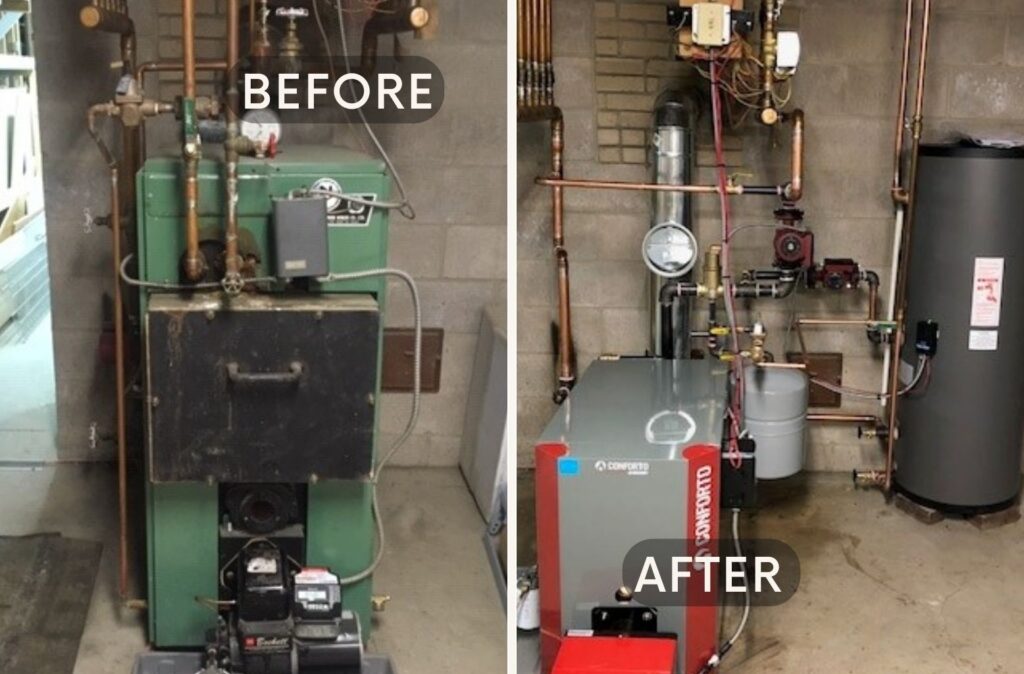 When your old oil-fired home furnace has reached the end of its useful life and it’s time to replace, don’t fret. Replacement is not a difficult or overwhelming endeavor. If you’re in the market for a new furnace, here’s a detailed look at what’s involved and the best time to undertake this project.
When your old oil-fired home furnace has reached the end of its useful life and it’s time to replace, don’t fret. Replacement is not a difficult or overwhelming endeavor. If you’re in the market for a new furnace, here’s a detailed look at what’s involved and the best time to undertake this project.
Initial Assessment and Planning
- Energy Audit: Is a great place to start as it will help you find additional places where you can improve the energy efficiency of your home.
- Quote Process: A visit from one of our licensed technicians or our foreman is all that is needed to receive a quote. In most cases the replacement process is simple. If you are looking to change/replace old piping, zoning, upgrading domestic hot water heating, technology upgrades, we can help with that. After the visit a quote will be prepared according to your needs and sent to you via email and/or mail.
- Review & Acceptance: Our quote will contain detailed information on the work we are prepared to undertake. The quote will also include various payment options. After you have had time to review, you can contact our office to ask any questions and/or book a time for the work to be done.
Site Preparation
- In most cases all that is needed is a clear and unobstructed access to the old furnace. If there is anything that is require ahead of time (i.e. shelves removed, door removed, etc.), it will be noted in the quote.
- We bring tarps to protect your floors while we work.
New Furnace Installation
- Disconnection and Removal: The old furnace will be carefully disconnected from the oil tank, water pipes (hydronic heating), ductwork (warm air heating), and electrical system, ensuring safe disposal. The old furnace will be removed and disposed of.
- Positioning: The new furnace will be placed in the designated location, ensuring it is level and securely installed.
- Connecting Systems: The furnace will be connected to the existing ductwork, piping, oil supply, and electrical system.
- Safety Measures: Necessary safety features will be installed, and proper ventilation verified.
System Integration
- Thermostat: Your current thermostat(s) will be checked or reprogrammed to ensure they work seamlessly with the new furnace.
- Zoning Systems: If applicable, the new furnace will be integrated with existing zoning systems for efficient heating control.
Testing and Inspection
- Initial Testing: The furnace will be turned on and tested to ensure it operates correctly and efficiently.
- Professional Inspection: A comprehensive inspection by one of our licenced technicians will verify that the installation meets all safety standards and regulations.
Final Adjustments and Cleanup
- Fine-Tuning: Adjustments will be made to optimize the furnace’s performance.
- Clean-up: The installation area will be thoroughly cleaned, and all debris, including the old furnace, will be properly disposed of.
Documentation and Maintenance
- Manuals and Warranties: You’ll receive all relevant manuals, warranties, and maintenance instructions for the new furnace.
- Maintenance Plan: A regular maintenance schedule will be discussed to ensure the longevity and efficiency of the new heating system.
The best time to replace your oil-fired home furnace is during the off-season, typically late spring to early fall. This timing offers a flexible schedule and minimal disruption to your comfort due to mild weather. Additionally, replacing your furnace before the heating season allows you to benefit from improved energy efficiency and lower heating costs throughout the winter.
At Scotia Fuels, we not only sell the latest energy-efficient furnaces, but we also have certified professionals on staff that can install your new furnace and get you up and running quickly. Want to know more about our modern oil-fired furnaces? Visit us at https://scotiafuels.com/contact-us/ or better still, call us at 902-453-2121. We’d love to talk to you.
